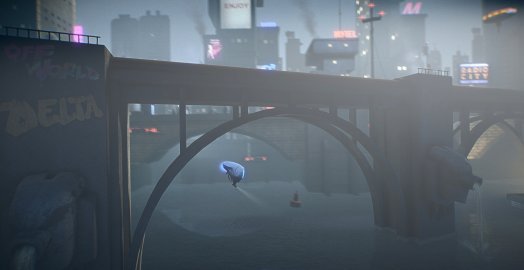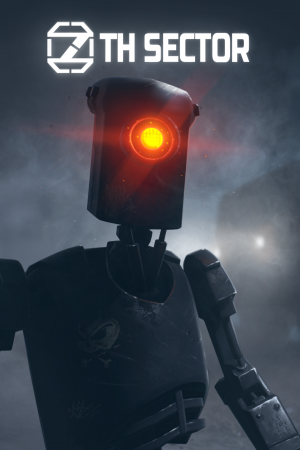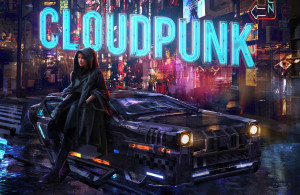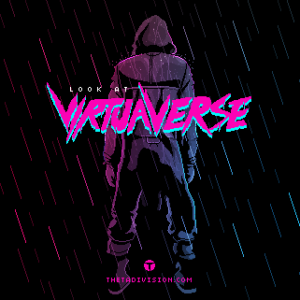Review for 7th Sector

Have you ever wondered what it would be like if you were deprived of your physical body and all you had was your “essence” left to inhabit inanimate objects to solve a wide variety of puzzles? Neither have I, but that is the premise of 7th Sector, the gritty sci-fi creation of indie developer Sergey Noskov, whose first game provides plenty of challenge as well as frustration. With just the barest narrative backdrop to its richly atmospheric setting, the many and often difficult puzzles and action sequences you need to solve along the way may leave you wondering at times if the reward is worth the effort.
While keyboard users are prompted at the start of the game about the major keys needed – A and D to move side to side, a few others to perform certain actions – there is nothing to show you how to crouch or scan, which you need to do to survive enemy encounters and solve puzzles. A key map for Xbox and PS4 controllers can be found in the menu options, but not a keyboard layout for PC, which is strange because the game was initially released as a PC exclusive and only then ported to consoles. I was able to figure out what to do by trial and error, but I experienced many deaths during this process.
There are two other technical aspects of note as well. The first is the many checkpoints you activate along the way (there are 48 in total). Unlike most autosave games, 7th Sector gives you the ability to reload your progress from any point, which at first seems pointless but is key to uncovering the four different endings if you wish to do so. The second relates to the scattered “HD” stands you find to capture various images of what is happening in your environment. These pictures and their accompanying captions add to the narrative once you begin to understand what is going on, and you can access them at any time via the main menu to review the story so far.
Gameplay begins with a vague outline of a person on a static-filled TV screen. Using either the keyboard or gamepad, you manage to jump off the TV screen and onto a wire as an active spark. From here you will move the spark along a wire to explore the environment and solve the many and varied puzzles you encounter. There is no early explanation for how this happened, but as you progress you will get clues that sort of explain your situation. There is no inventory to worry about and no characters to interact with. It is a very solitary experience, which is in keeping with the plot and story, although this is subject to interpretation.
I was quite impressed with the inventiveness, originality, and quantity of the obstacles in the way. There is no doubt that a lot of thought and creativity went into the puzzle design. For example, as a simple spark traveling along a cable, what can you do? As it turns out, quite a bit. You can create connections by overloading a lightbulb to break it and expose a circuit so that you can jump to the next wire and progress, align steel balls, activate a phonograph to listen to a specific soundtrack, inhabit a radio and enter a secret code by manipulating the mechanism, overload cooling fans to disable a barrier, solve a tile puzzle to align concentric shapes, and much, much more.
It won’t be long before you experience the price of failure. If you make the slightest mistake when trying to jump back and forth between various cables or objects, or run into hostile entities such as yellow or red sparks travelling along your path, often you are abruptly sent back to the beginning of the last checkpoint. In most cases you need to replay only a minute or two to get back to where you were, but in some instances it can be up to five minutes. Through trial and error you will eventually make it through all the obstacles in your way, but this theme persists throughout the game and only gets more challenging as the levels become more difficult.
When all possibilities as a mere spark entity have been exhausted, you will briefly inhabit a ball (similar to BB-8 from Star Wars) inside a child’s bedroom, but now you are rolling along the floor and using the left/right arrow keys to move around. The ball has magnetic properties you can use to solve puzzles to advance, such as ramming a metal bar blocking your way that can then be directed where you need it to go. And you can still zap various objects to get around certain tricky areas.
Next your consciousness inhabits a spider-like droid to continue your journey, this time across a battlefield-like area. This was my favourite part of the game, as you acquire a new ability with a top-mounted gun you can adjust and shoot on command (although it can overheat if you shoot too long). This proves useful in defending yourself against many similar machines trying to kill you, as well as overcoming obstacles such as doors and power wheels by shooting key areas. You will encounter a tough battle with other droids that requires quick thinking and maneuvering, as you need to figure out the best spot from which to kill your opponents and avoid them at times, which is not easy using the keyboard. In firefights like this (and there are several throughout the game), it is probably best to use a gamepad, but not owning one it took me a while to get past these areas.
Your next incarnation is as a free-flying drone that retains the zapping ability but adds a scanner that you can use to check out different areas in this new level for clues and interaction points. You are finally able to maneuver up and down, which allows you to move objects vertically rather than just side to side, though you’ll need to avoid being attacked from the ground or above by bobbing and weaving as you navigate your way. This ability lets you travel underwater to explore areas below buildings and to adjust water levels in storage tanks. And just when you think you have seen everything, you encounter a “boss fight” where a huge ghost-like man tries to swat you out of the sky as you fly around trying to defeat him by repeatedly affecting the environment around him. While this is pretty easy to do, I don’t understand why the developer would add this to the game as it just seemed out of place.
After this fight you return to being a sentient spark once again, travelling along wires where you must face yet another timed puzzle to move back and forth from cable to cable to avoid the bad red sparks. You will eventually encounter a computer terminal with many options based on the codes and colours of those on the display. Once you have solved this puzzle, you’ll embody one last form with which to make your way to the endgame.
While I enjoyed the variety of different tasks along the way, there were a few frustrating (almost infuriating) puzzles that took me many attempts to complete. It’s not that the puzzles were difficult to figure out – I knew what to do – but the keyboard controls are so finicky that even the most dexterous player will have trouble solving them with only a few failures. One example is operating a toy car you control once you “zap” into it from the BB-8 ball to move paint cans and other objects into an elevator to activate it. It is very easy to slip up and have to regroup and try again. Another challenge that exasperated me was the need to move three different bricks to a bin in order for it to open. You have to balance them on your back as the flying drone, but the slightest imbalance would cause the brick to fall, forcing you to go back and start again. I would have much appreciated the option to set the difficulty level for these kinds of tasks, or to bypass them entirely once you have failed a certain number of times.
Another design choice I struggled with was the need for stealth to avoid being seen by rotating cameras and patrolling droids while attempting to achieve certain goals. Again, because almost all gameplay is done via the keyboard on PC (the mouse is almost never used), you require nimble fingers to run and stop in exactly the right spot near objects that cast a shadow for you to hide behind. I had trouble moving to and stopping in each precise spot needed before I got spotted.
And while I am venting, there is a maze, and this one is a doozy. As the flying drone, you must locate four different beacons and deactivate them while being chased by a killer drone and impeded by slow-moving maintenance drones. While there are some distinctive markings and features in the maze that can help you map it, it is expansive so getting lost is easy. When you get close to one of the beacons, the sound it emits gets louder (in fact, there are many “hot and cold” puzzles like this in the game), but it will take a lot of exploration (and dying, so you must start over from scratch) before you find all four and are able to leave the area. Here, too, the ability to skip a puzzle like this would be welcome to those non-masochistic players out there.
Throughout 7th Sector you will encounter math problems called “transformer” challenges contained in consoles you can access. While your natural tendency will surely be to solve each one you come across, it turns out that doing so will deprive you of the opportunity to see two of four possible endings. There is no indication of this as you play, and of course I solved them, assuming this would be necessary to advance. Only after I consulted a walkthrough did I realize this was a mistake, and in conjunction with another late-game branch point, I ended up with what I consider to be the worst ending available.
Graphically the game paints a dark picture, with muted blues and grays and an overall sense that things are not going well. While your avatar and its immediate surroundings are crisp and clear, the backgrounds are out of focus and portray troubling events. Citizens run around in panic while robots seem to be assembling for crowd control or worse. It appears that humans and machines are at war, but the cause is not at all evident. As with all wars, there is a fair bit of violence and gore here. You will see bloody corpses, people being gunned down in the background as the fighting escalates, limbs and even heads blown off, and more. While there are no scenes of blood gushing or anything like that, these images effectively convey the horror of what is happening around you.
Sound design is well done, with excellent effects ranging from the soft hum of your flying drone to the clanking of metallic feet as you walk in the form of a mini-tank. Synth music plays in many but not all areas, and while it repeats at times it never gets annoying. When things grow tense, the score is suitably amped up, adding much to the urgency of your situation.
The story is told in an interesting way. Events unfold in the background as you progress through the puzzles, so you need to pay attention, which is sometimes hard to do when you are focused on the challenge at hand. Without giving away details of the plot or the different endings, many people can be seen wearing what look like VR headsets, and it appears that some of them are being controlled, which could explain what seems to be rioting and civil unrest. If you look closely, you will see a recurring image of a man wearing glasses, a hat and trench coat, who appears to be a key player in what is going on. While I did my best to try to make sense of these background events, I was never sure what exactly was happening and why. Have the robots become sentient, and if so what is the result of the conflict with their creators? Who is behind this? And what is your role?
Along the way you will also stumble across TV sets with a static display, and when you linger near them for long enough you will see a short video. These are called “phantoms” and the main menu screen displays how many you have uncovered of the total number available. You will also see the status of the number of transformers you have solved. Oddly, some rarely seen other details occasionally appear on-screen as well, such as basic information about your PC configuration including PC name, total RAM, screen resolution and session time for gameplay. I am not sure why the developer chose to include these details other than to remind you what your current settings are and how long you have been playing (perhaps it is time to go to bed!).
In my case, it took me about seven hours to complete my playthrough, though some of that was spent struggling with the keyboard controls. While there are four different endings, only the most patient and attentive player will be able to achieve them all without consulting a walkthrough, even if you feel so inclined to play through the game twice entirely and parts of two more just to see additional endings, none of which are particularly satisfying. If you are curious to see which ones you missed, there are videos online you can check out to appease your curiosity with instant gratification.
Overall, 7th Sector left me with mixed feelings. It offers a richly disturbing atmosphere with a nice range of challenging puzzles to solve, but they come with lots of side-scrolling action blended in, which makes for a welcome change of pace but is harder than it needs to be with its troublesome keyboard controls. (Gamepad owners, your mileage will vary.) It does have a story, but it’s told in a very abstract way that raises at least as many questions as it answers. If you don’t mind a little stealth and gunfighting in your adventures, you will probably find it worthwhile. If you are more of an adventure traditionalist, I expect you will be frustrated with certain aspects. Either way, the ending is a bit of a letdown, no matter which one you get, but the journey to that point is a varied and often entertaining if unnecessarily bumpy ride.





























